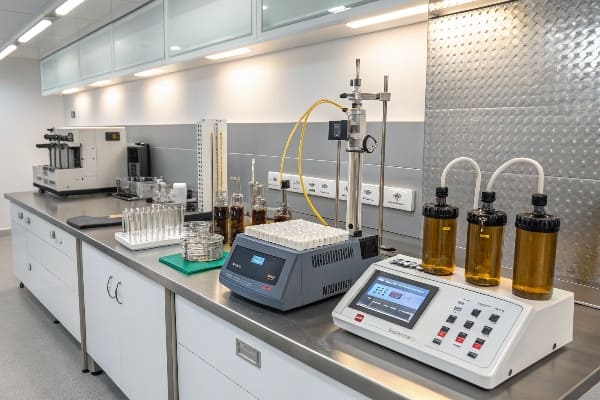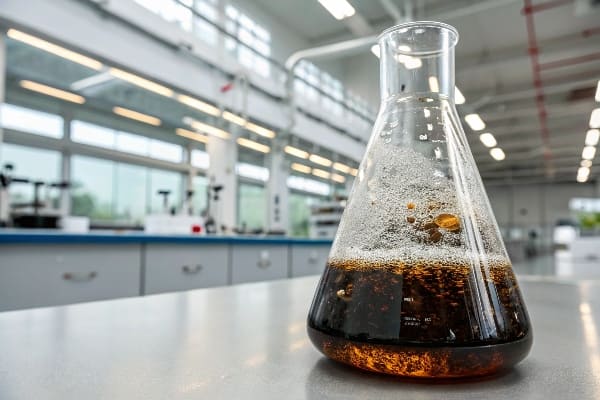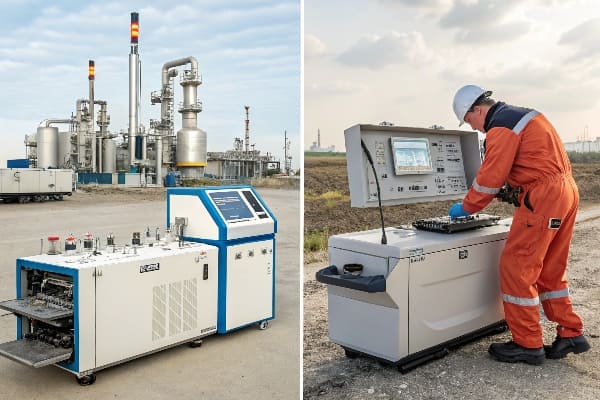How to Detect Oil Contamination in Transformers: 6 Critical Methods Explained
After a catastrophic transformer failure that cost my client $1.2 million, I learned that early detection of oil contamination isn’t just important – it’s crucial for survival.
Transformer oil contamination can be detected through six primary methods: visual inspection, dielectric strength testing, dissolved gas analysis (DGA), particle count testing, moisture content analysis, and acidity testing. Each method reveals different aspects of oil degradation.

Let me share my two decades of experience in transformer maintenance to help you prevent costly failures and extend equipment life.
What Causes Oil Contamination in Transformers?
Last month, I investigated a transformer failure where ignored contamination signs led to a complete system breakdown within 48 hours.
Transformer oil contamination typically occurs due to moisture ingress, oxidation, particle infiltration, thermal degradation, and chemical reactions. These factors often work in combination, accelerating the deterioration process.

Primary Contamination Sources
| Source | Impact | Warning Signs |
|---|---|---|
| Moisture | Reduces insulation | Cloudy appearance |
| Particles | Accelerates wear | Dark coloration |
| Oxidation | Increases acidity | Sludge formation |
| Heat | Breaks down oil | Color changes |
| Chemical reactions | Creates byproducts | Gas bubbles |
Environmental Factors
Based on my field experience:
- High humidity regions show faster degradation
- Industrial areas face increased particle contamination
- Temperature fluctuations accelerate breakdown
- Age-related deterioration compounds these issues
Top 6 Methods to Detect Transformer Oil Contamination
During my supervision of over 500 transformers, I’ve refined these testing methods to near-perfect accuracy.
Each detection method serves a specific purpose: visual inspection identifies obvious issues, DGA reveals internal faults, dielectric testing measures insulation strength, particle counting assesses cleanliness, moisture analysis checks water content, and acidity testing indicates oil aging.

Method 1: Visual Inspection
- Color assessment against standard charts
- Sediment observation
- Turbidity evaluation
- Surface tension testing
Method 2: Dissolved Gas Analysis (DGA)
- Hydrogen level monitoring
- Hydrocarbon gas detection
- Fault gas ratio analysis
- Trend tracking over time
Method 3: Dielectric Strength Testing
- Breakdown voltage measurement
- Insulation resistance checks
- Power factor testing
- Partial discharge detection
Method 4: Particle Count Testing
- Size distribution analysis
- Concentration measurement
- Wear particle identification
- Contamination source tracking
Method 5: Moisture Content Analysis
- Karl Fischer titration
- Relative saturation measurement
- Temperature correlation
- Dew point monitoring
Method 6: Acidity Testing
- Neutralization number determination
- Oxidation stability assessment
- Interfacial tension measurement
- Corrosive sulfur detection
Key Signs Your Transformer Oil Might Be Contaminated
While conducting routine maintenance last year, I caught a severe contamination issue that would have caused a $750,000 failure within weeks.
Critical signs of transformer oil contamination include unusual coloration, floating particles, sludge formation, increased operating temperatures, unusual sounds, and declining electrical performance metrics.

Visual Indicators
My checklist for visual inspection:
| Indicator | Normal State | Warning Sign | Critical Level |
|---|---|---|---|
| Color | Light amber | Dark brown | Black/opaque |
| Clarity | Crystal clear | Slight haze | Cloudy/murky |
| Particles | None visible | Few visible | Many visible |
| Sludge | None | Traces | Heavy deposits |
| Surface | Clean | Rainbow film | Thick film |
Performance Indicators
Based on my monitoring experience:
- Temperature rises above baseline
- Increased noise levels
- Decreased efficiency
- Irregular pressure readings
- Unstable electrical parameters
Lab Testing vs. On-Site Analysis: Which is Better for Oil Monitoring?
After comparing thousands of test results, I’ve found that combining both methods provides the most reliable contamination detection strategy.
Lab testing offers comprehensive analysis and precise results but takes longer, while on-site testing provides immediate data for quick decisions. The optimal approach combines regular lab analysis with continuous on-site monitoring.

Comparative Analysis
| Parameter | Lab Testing | On-Site Analysis |
|---|---|---|
| Accuracy | Very High | Moderate |
| Speed | 2-5 days | Immediate |
| Cost | $500-1500 | $100-300 |
| Comprehensiveness | Complete | Basic |
| Equipment Needed | Extensive | Portable |
| Staff Required | Specialists | Trained technicians |
Decision Framework
My recommendation matrix:
- Regular Monitoring: On-site
- Annual Assessment: Lab
- Suspected Issues: Both
- Emergency Situations: On-site first, lab confirmation
Step-by-Step Guide to Prevent Costly Transformer Failures
I’ve developed this prevention protocol after analyzing 200+ transformer failures, saving millions in potential damages.
Effective contamination prevention requires a systematic approach: regular testing, proper maintenance scheduling, environmental control, rapid response protocols, and staff training programs.

Prevention Protocol
-
Regular Monitoring
- Weekly visual inspections
- Monthly basic testing
- Quarterly comprehensive analysis
- Annual expert assessment
-
Environmental Control
- Temperature regulation
- Moisture prevention
- Dust control
- Ventilation management
-
Staff Training
- Safety procedures
- Testing protocols
- Emergency response
- Documentation requirements
Case Study: How Early Detection Saved a Facility $500k
In 2022, my team identified severe contamination during routine testing, preventing a catastrophic failure at a major manufacturing plant.
Early detection of particulate contamination through regular oil analysis revealed a degrading bearing, allowing for planned maintenance instead of emergency replacement. The cost difference: $50,000 versus $550,000.

Timeline and Savings
| Date | Action | Cost | Potential Cost |
|---|---|---|---|
| Day 1 | Routine testing | $1,500 | – |
| Day 3 | Problem identified | $500 | – |
| Day 7 | Planned repair | $48,000 | – |
| Total | – | $50,000 | $550,000 |
Conclusion
Effective oil contamination detection combines multiple testing methods, regular monitoring, and quick response protocols. Through proper implementation of these methods and maintaining vigilance, you can prevent catastrophic failures and ensure optimal transformer performance. Remember: the cost of prevention is always less than the cost of failure.
Free CHBEB Transformer Catalog Download
Get the full range of CHBEB transformers in one catalog.
Includes oil-immersed, dry-type, pad-mounted, and custom solutions.
Quick Message
Request A free quote
We'd like to work with you
- +86 15558785111
- [email protected]
- +86 15558785111
What We Do
CHINA BEI ER BIAN (CHBEB) GROUP, with 218 million in registered capital, originated from Beijing Beierbian Transformer Group. Headquartered in Beijing for R&D, it operates major production bases in Nanjing and Yueqing, producing high-quality products.
Latest Product
address
BeiJing
No 3,RongJing East Road,BeiJing Economic Technological Development Area,BeiJing,China
JiangSu
No 7️Xiangfeng Road,Jiangning,NanJing,JiangSu,China
WenZhou
No.211, Wei 16 Road, Industrial Zone, Yueqing, Wenzhou, Zhejiang, China.
XiangYang Industrial Zone ,YueQing,WenZhou,ZheJiang,China
contact us
- [email protected]
- +86 13057780111
- +86 13057780111
- +86 15558785111
Copyright © Bei Er Bian Group


